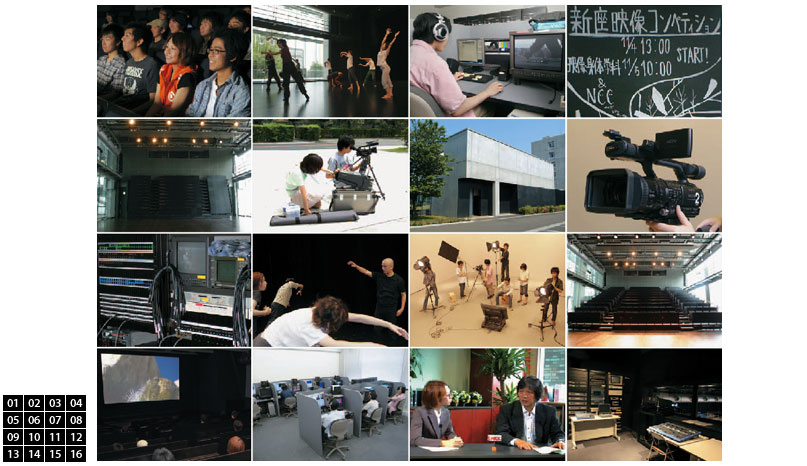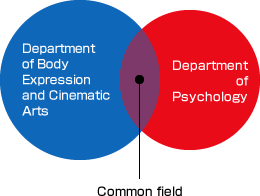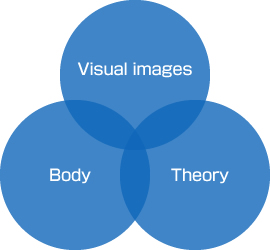OverviewBody Expression and Cinematic Arts
Humanbeing as interaction of mind and body
The Department of Body Expression and Cinematic Arts is a completely new department devoted to the pursuit of thought and expression centering on the body and visual imagery. While the Department of Psychology takes a multifaceted approach to problems of the mind, the Department of Body Expression and Cinematic Arts is concerned with the human body as the physical manifestation of the mind, the external environment as an extension of the body, and the world of visual images which provides us with a multitude of environmental information. The Department perceives humans as the mutual interaction of the mind and body and aims to establish a new type of human studies for the 21st century through close examination of the relationship between flesh-and-blood human beings and mechanical visual images.
Students acquire knowledge in the two core areas of the body and visual imagery for use as a launch point in their respective studies of ‘Body Expression’ and ‘Cinematic Arts’. In Body Expression, students learn about ideology, medical science, techniques, and expression relating to the body throughout human civilization in order to reorganize their knowledge of the body into a comprehensive ‘science of the body’, which is then tied into physical performance and examined as a central theme of new human studies for the 21st century. In Cinematic Arts, students develop a broad understanding of machine-based visual imagery which has permeated contemporary society more than any other medium, and engage in multifaceted research on the power and potential of mechanical visual images, which are intimately connected to the nature of the human body and senses, as a new type of science of the imagery . In this way, students expand their knowledge of visual images and the body through overlapping studies in each field.
Specialized learning begins in the first year, while practical learning and the underlying theory of visual images and the body spans the full four years of the course. Students also accumulate technical and practical expertise in each field, and are challenged to approach philosophical and social theory construction with insight and, above all else, an open mind. The four years of study culminate in the creative work and thesis required for graduation. It is our hope that the creativity and intelligence fostered here will enable students to meet the diverse needs of society and provide them with a significant advantage in becoming leaders of their generation.
Students acquire knowledge in the two core areas of the body and visual imagery for use as a launch point in their respective studies of ‘Body Expression’ and ‘Cinematic Arts’. In Body Expression, students learn about ideology, medical science, techniques, and expression relating to the body throughout human civilization in order to reorganize their knowledge of the body into a comprehensive ‘science of the body’, which is then tied into physical performance and examined as a central theme of new human studies for the 21st century. In Cinematic Arts, students develop a broad understanding of machine-based visual imagery which has permeated contemporary society more than any other medium, and engage in multifaceted research on the power and potential of mechanical visual images, which are intimately connected to the nature of the human body and senses, as a new type of science of the imagery . In this way, students expand their knowledge of visual images and the body through overlapping studies in each field.
Specialized learning begins in the first year, while practical learning and the underlying theory of visual images and the body spans the full four years of the course. Students also accumulate technical and practical expertise in each field, and are challenged to approach philosophical and social theory construction with insight and, above all else, an open mind. The four years of study culminate in the creative work and thesis required for graduation. It is our hope that the creativity and intelligence fostered here will enable students to meet the diverse needs of society and provide them with a significant advantage in becoming leaders of their generation.

01/ Fostering the ‘ability to see’ is another Department aim 02/ Students hone their sensory perception through physical movement 03/ Acquiring editing skills through practice 04/ Department and student group’s joint participation in a university festival 05/ Physical classes require plenty of space 06/ Students can borrow equipment for video production 07/ The fully equipped ‘Film Studio’ building 08/ HDV camera equipment used for filming 09/ TV station-standard equipment for student research 10/ Students learn physical techniques through practical activities with teachers 11/ Planning and teamwork are essential when filming 12/ Classroom seating can be rearranged for lectures and performances 13/ Theater-type classroom equipped with high-definition equipment 14/ Editing often takes considerable time 15/ The inaugural class produced a video introducing the Department 16/ Body and visual image study methods are interlinked
Relationship with the Department of Psychology

The Department of Body Expression and Cinematic Arts explores a new type of human studies amidst the multi-dimensional world of mind, body, and environment through the study of visual expression, visual production, physical expression, and physical techniques. In addition to ‘technical knowledge’ of visual imagery, the body and machines, and ‘humanities and social science knowledge’ of art, aesthetics, philosophy, sociology and history, there is also a strong requirement on the introduction of ‘scientific knowledge’ obtained through experimentation, data, analysis, and theory. In fact, the Department of Body Expression and Cinematic Arts regards the scientific results of human psychology and behavior as well as cognitive and mental systems as a constant bellwether. Both the students and teachers learn psychological research methods and outcomes, and develop their self-image in relation to self, society, and the environment, which must all then be objectively confirmed as ‘knowledge’. Knowledge of psychology is indispensable in production and performance settings, as well as in expression and theory construction.searching out new forms of knowledge that integrate science, philosophy, and the arts.
Concept
Body Expression and Cinematic Arts is a totally new field of learning characterized by methods for exploring human nature. The concept of this Department lies in the attempt to create a new type of human studies in response to the modern age by exploring the considerable impact of machine-based visual images on human sensory perception and expression, as well as the new reality that dynamic physical expression has brought to the world of visual imagery. We are attempting to develop this new type of human studies by seeking to understand the relationships that exist between the body and sensory perception and the outside world and machine-based images, as well as the mechanisms by which the body absorbs visual images and its environment. While this discipline is still in its infancy, it features a diverse range of subjects linking theory and practice, technology and thought, and science and art, as well as intellectual collaboration among the teaching faculty who deftly merge practical situations with cutting-edge theory.This makes for a highly attractive environment for young people seeking to harness their energy and creativity within contemporary society. We invite you to participate in this challenge to apply novel cross-departmental methods to the traditional College of Contemporary Psychology.

Theory surrounds visual and body expression, and is a ubiquitous element of academic learning such as philosophy, psychology, the arts, science, and business. Where the body, visual images, and theory overlap, there exists the potential for new types of expression.
